Attractions · Europe · Food and Drink · France · Going Out · Regions · Travel Miscellany · Western Europe
9 reasons why it’s great in Grenoble
This year, Forbes declared Grenoble one of Europe’s top 5 inventive cities, and with a growing amount of student engineers, it’s been giving Silicon Valley a run for its money. In 2016 it was voted the best city in France to be a student, as well as having the highest level of accessibility for wheelchair users in France. Not only this, but the city is run by a Green Party, making it a leader for environmental progress. Here are 9 ways to enjoy this forward-thinking city:
 1. Be greeted by a local ‘Grenoblois’
As with many French cities, Grenoble operates a greeter system. A greeter is a volunteer (not a professional) who is passionate about their own city and is enthusiastic to show visitors around, so whether you are travelling solo or as group, meeting a local is one of the best ways to learn about a city in a very unique and personal way. I was lucky enough to be visiting a friend who lives and works in Grenoble as a musician, who gave me lots of tips and advice that I would not have been able to find on the internet. I also came across the gentleman below singing beautiful opera in the gardens, he took the time to talk with me about how much he loved his city, although much of it was lost on me as I am not yet fluent in French.
1. Be greeted by a local ‘Grenoblois’
As with many French cities, Grenoble operates a greeter system. A greeter is a volunteer (not a professional) who is passionate about their own city and is enthusiastic to show visitors around, so whether you are travelling solo or as group, meeting a local is one of the best ways to learn about a city in a very unique and personal way. I was lucky enough to be visiting a friend who lives and works in Grenoble as a musician, who gave me lots of tips and advice that I would not have been able to find on the internet. I also came across the gentleman below singing beautiful opera in the gardens, he took the time to talk with me about how much he loved his city, although much of it was lost on me as I am not yet fluent in French.
 2. Ride a red bubble
This short, but sweet cable car ride was the first of its kind built in 1934. Originally the cars were octagonal in design, with the bubble shape being introduced later on in 1976. As the bubble lifts up into the sky, it hovers over the colourful houses lining the banks of the winding River Isère briefly, before revealing the flattest expanse of city in France, home to just under 160,000 inhabitants. In the distance, misty mountains hug the entire periphery of the city. We float over the rooftops of a derelict university and the Musée Dauphonoise, which is worth a visit on the way down. At the top we are greeted by golden-copper trees now in full autumnal bloom. TIP: Make sure to take the last bubble in the set of four for an unobscured view (or on the way down, the first bubble).
2. Ride a red bubble
This short, but sweet cable car ride was the first of its kind built in 1934. Originally the cars were octagonal in design, with the bubble shape being introduced later on in 1976. As the bubble lifts up into the sky, it hovers over the colourful houses lining the banks of the winding River Isère briefly, before revealing the flattest expanse of city in France, home to just under 160,000 inhabitants. In the distance, misty mountains hug the entire periphery of the city. We float over the rooftops of a derelict university and the Musée Dauphonoise, which is worth a visit on the way down. At the top we are greeted by golden-copper trees now in full autumnal bloom. TIP: Make sure to take the last bubble in the set of four for an unobscured view (or on the way down, the first bubble).
 3. Fort de la Bastille
The cable car (or teleferique) lands you right on the walls of this 19th century hill-top fortification. This isn’t just a historical site, it also houses an art exhibition, restaurants, museums, an adventure trail for kids, a zip-line and an array of events throughout the year, which include dancing and music. If you have hiked up, take a coffee and rest at Restaurant le Téléférique while absorbing the incredible panoramic views. It’s a great place to start your trip, as you can get a good idea of the city from this vantage point. Take your time to explore the maze of corridors connected by stone staircases, offering secluded areas for a quiet moment away from the crowds. One steep, narrow staircase leads right down through a dark mountain and out the other side. If you still have energy, just a 30 min easy uphill hike using trail GR9, will take you to the Memorial at Mont Jalla, at an elevation of 643m, the view is even wider but there are a lot less people here. It’s worth staying to watch the city light up as the sun goes down. Every evening, there are hundreds of joggers with headlamps weaving their way up and down the side of the hill. If you choose to walk back down to town, you will be rewarded with a mesmerising light show at the bottom, a projection of moving geometric patterns, like the seed of life, bring the dark stone walls to life. TIP: I recommend bringing a torch, especially if you plan to walk down after sunset as it’s pitch black.
3. Fort de la Bastille
The cable car (or teleferique) lands you right on the walls of this 19th century hill-top fortification. This isn’t just a historical site, it also houses an art exhibition, restaurants, museums, an adventure trail for kids, a zip-line and an array of events throughout the year, which include dancing and music. If you have hiked up, take a coffee and rest at Restaurant le Téléférique while absorbing the incredible panoramic views. It’s a great place to start your trip, as you can get a good idea of the city from this vantage point. Take your time to explore the maze of corridors connected by stone staircases, offering secluded areas for a quiet moment away from the crowds. One steep, narrow staircase leads right down through a dark mountain and out the other side. If you still have energy, just a 30 min easy uphill hike using trail GR9, will take you to the Memorial at Mont Jalla, at an elevation of 643m, the view is even wider but there are a lot less people here. It’s worth staying to watch the city light up as the sun goes down. Every evening, there are hundreds of joggers with headlamps weaving their way up and down the side of the hill. If you choose to walk back down to town, you will be rewarded with a mesmerising light show at the bottom, a projection of moving geometric patterns, like the seed of life, bring the dark stone walls to life. TIP: I recommend bringing a torch, especially if you plan to walk down after sunset as it’s pitch black.
 4. Hiking the Col de Vence
There are so many hiking routes it would be impossible to list them all, especially since there are 3 separate mountain ranges to choose from; the Chartreuse, the Vercors and the Belledonne. The Bastille links with the Chartreuse range, so this one is the most accessible from the city centre. Just a 30 minute ride north-west of town, near the Restaurant La Chapelle, a trail leads up through the woods and zig-zags its way under the shade of bronzed trees. Glimpses of the city far below start to appear at each bend in the road. I pass a silver-haired mountain biker who must have been in his 60s. The older generation do like to keep fit here! One hour later, the forest opens up to show hillside caves with iron gates half open, inviting me in to the cool dark interior. Next a steep stone staircase leads up to a windy plateau, where a lone donkey is grazing in the peaceful solitude at an elevation of 1338m . Mont Blanc can be seen in the distance. From here it’s a short walk downhill to Fort du Saint-Eynard, which was built for the protection ofGrenoble in the 1870s, but now houses a museum, restaurant and chapel. The views of the city, again, are magnificent! A small white engine-less glider silently sweeps above my head like a paper plane, I envy the view it must be getting. TIP: For the clearest view, try and hike the day after it has rained, as the rain will clear the thin veil of smog which hangs over the city much of the time.
4. Hiking the Col de Vence
There are so many hiking routes it would be impossible to list them all, especially since there are 3 separate mountain ranges to choose from; the Chartreuse, the Vercors and the Belledonne. The Bastille links with the Chartreuse range, so this one is the most accessible from the city centre. Just a 30 minute ride north-west of town, near the Restaurant La Chapelle, a trail leads up through the woods and zig-zags its way under the shade of bronzed trees. Glimpses of the city far below start to appear at each bend in the road. I pass a silver-haired mountain biker who must have been in his 60s. The older generation do like to keep fit here! One hour later, the forest opens up to show hillside caves with iron gates half open, inviting me in to the cool dark interior. Next a steep stone staircase leads up to a windy plateau, where a lone donkey is grazing in the peaceful solitude at an elevation of 1338m . Mont Blanc can be seen in the distance. From here it’s a short walk downhill to Fort du Saint-Eynard, which was built for the protection ofGrenoble in the 1870s, but now houses a museum, restaurant and chapel. The views of the city, again, are magnificent! A small white engine-less glider silently sweeps above my head like a paper plane, I envy the view it must be getting. TIP: For the clearest view, try and hike the day after it has rained, as the rain will clear the thin veil of smog which hangs over the city much of the time.
 5. Explore the city
The best way to see as much of the city as possible is to hire a bike from the Metrovelo at Grenoble station and get cycling. The city has wide main roads, and smaller pedestrianised streets, making it easy for cyclists, but if you are not a fan of cycling, walking is just as enjoyable. As well as some unusual architecture, such as the Evangelist church pictured below, there’s a fair amount of murals to be found for street-art enthusiasts and gorgeous markets with colourful bouquets of local produce. One of my favourites is the Marche de l’Estacade, which is housed under what looks like a railway. Art nouveau style illustrations of trees and market scenes adorn the columns and facades. For a more centrally located market, try Place aux Herbes on a Sunday.
5. Explore the city
The best way to see as much of the city as possible is to hire a bike from the Metrovelo at Grenoble station and get cycling. The city has wide main roads, and smaller pedestrianised streets, making it easy for cyclists, but if you are not a fan of cycling, walking is just as enjoyable. As well as some unusual architecture, such as the Evangelist church pictured below, there’s a fair amount of murals to be found for street-art enthusiasts and gorgeous markets with colourful bouquets of local produce. One of my favourites is the Marche de l’Estacade, which is housed under what looks like a railway. Art nouveau style illustrations of trees and market scenes adorn the columns and facades. For a more centrally located market, try Place aux Herbes on a Sunday.
 6. Art class at the Musée de Grenoble
The Museum of Grenoble has an inspiring collection of both ancient and contemporary art. As I soak in the colours and shapes, I notice a group of mature students being led by an art teacher. They attempt to sketch a copy of ‘Boxers’, a cubist painting by Vicente Do Rego Monteiro from the 50s, which has soft curved lines and graduated shading. What better place to practice drawing and become part of the artistic process than surrounded by works of art from the great masters! It’s interesting that Grenoblois can even borrow paintings from their local libraries for short periods of time at no cost at all, just like borrowing a book!
6. Art class at the Musée de Grenoble
The Museum of Grenoble has an inspiring collection of both ancient and contemporary art. As I soak in the colours and shapes, I notice a group of mature students being led by an art teacher. They attempt to sketch a copy of ‘Boxers’, a cubist painting by Vicente Do Rego Monteiro from the 50s, which has soft curved lines and graduated shading. What better place to practice drawing and become part of the artistic process than surrounded by works of art from the great masters! It’s interesting that Grenoblois can even borrow paintings from their local libraries for short periods of time at no cost at all, just like borrowing a book!
 7. La Millesime festival
This locally curated festival is now in its 23rd year and takes place for 2 weeks every October right in the centre of Grenoble. Whether you are an oenophile or a neophyte, you will discover something new every year, with a selection of wines from some 50 producers, as well as foie gras, cheese and meats from select regions. This is all accompanied by live music performances by renowned concert musicians and singers as well as showcasing new talent. The festival really focuses on wine, with tastings, workshops and a large smelling tent with aroma bottles, which give an example of the different notes that can be found within a glass of wine.
7. La Millesime festival
This locally curated festival is now in its 23rd year and takes place for 2 weeks every October right in the centre of Grenoble. Whether you are an oenophile or a neophyte, you will discover something new every year, with a selection of wines from some 50 producers, as well as foie gras, cheese and meats from select regions. This is all accompanied by live music performances by renowned concert musicians and singers as well as showcasing new talent. The festival really focuses on wine, with tastings, workshops and a large smelling tent with aroma bottles, which give an example of the different notes that can be found within a glass of wine.
 8. Local cuisine
Grenoble is known for traditional dishes such as gratin dauphinois and creme brûlée, but the food in this city is really more varied and exciting. Sitting at the K fee des Jeux, I decide on the ‘Plat du Jour’ which starts with a terrine of herring and raspberry and a walnut salad. Walnuts of exceptional quality are produced in Grenoble, so if you see it on the menu, it’s likely to be a good choice! The second course is a hearty portion of steamy Canard stew, with tender pieces of duck, wild mushrooms and prunes, served with wheatberries. The autumnal theme continued at Le Cotelette restaurant (pictured below) whose rustic brick coves were decorated with dried leaves and wine coloured rugs. Soothing piano music played in the background as I enjoyed a Salmon Tartare and a glass of Chartreuse, which comes in a strong green or sweet yellow version. It’s produced at the local monastery, which sits on the mountain range of the same name, by monks who have taken a vow of silence. The complex flavour comes from a mixture of 130 herbs, flowers and spices which are slowly aged in oak casks. Queen Elizabeth allegedly loves a shot of Chartreuse added to her champagne!
8. Local cuisine
Grenoble is known for traditional dishes such as gratin dauphinois and creme brûlée, but the food in this city is really more varied and exciting. Sitting at the K fee des Jeux, I decide on the ‘Plat du Jour’ which starts with a terrine of herring and raspberry and a walnut salad. Walnuts of exceptional quality are produced in Grenoble, so if you see it on the menu, it’s likely to be a good choice! The second course is a hearty portion of steamy Canard stew, with tender pieces of duck, wild mushrooms and prunes, served with wheatberries. The autumnal theme continued at Le Cotelette restaurant (pictured below) whose rustic brick coves were decorated with dried leaves and wine coloured rugs. Soothing piano music played in the background as I enjoyed a Salmon Tartare and a glass of Chartreuse, which comes in a strong green or sweet yellow version. It’s produced at the local monastery, which sits on the mountain range of the same name, by monks who have taken a vow of silence. The complex flavour comes from a mixture of 130 herbs, flowers and spices which are slowly aged in oak casks. Queen Elizabeth allegedly loves a shot of Chartreuse added to her champagne!
 9. Sweet treats
The worst thing about a real French Patisserie, is having to decide which pastry to eat. Time and effort are put into each exquisite hand-made pastry at Paris Delicies. Juicy, shiny fruits sit atop creamy sweet custard on a base of light, fluffy, flaky pastry. For chocolate lovers, look out for Chocolate Walnuts at La Caraque chocolate shop, which make a delicious gift to take away with you.
9. Sweet treats
The worst thing about a real French Patisserie, is having to decide which pastry to eat. Time and effort are put into each exquisite hand-made pastry at Paris Delicies. Juicy, shiny fruits sit atop creamy sweet custard on a base of light, fluffy, flaky pastry. For chocolate lovers, look out for Chocolate Walnuts at La Caraque chocolate shop, which make a delicious gift to take away with you.

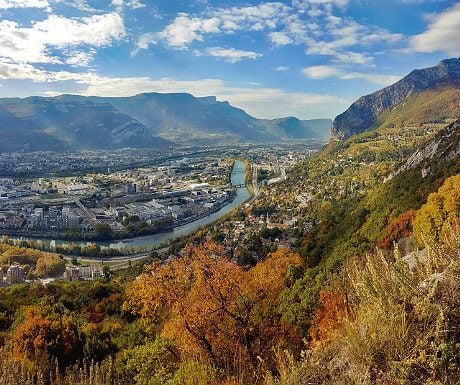 1. Be greeted by a local ‘Grenoblois’
As with many French cities, Grenoble operates a greeter system. A greeter is a volunteer (not a professional) who is passionate about their own city and is enthusiastic to show visitors around, so whether you are travelling solo or as group, meeting a local is one of the best ways to learn about a city in a very unique and personal way. I was lucky enough to be visiting a friend who lives and works in Grenoble as a musician, who gave me lots of tips and advice that I would not have been able to find on the internet. I also came across the gentleman below singing beautiful opera in the gardens, he took the time to talk with me about how much he loved his city, although much of it was lost on me as I am not yet fluent in French.
1. Be greeted by a local ‘Grenoblois’
As with many French cities, Grenoble operates a greeter system. A greeter is a volunteer (not a professional) who is passionate about their own city and is enthusiastic to show visitors around, so whether you are travelling solo or as group, meeting a local is one of the best ways to learn about a city in a very unique and personal way. I was lucky enough to be visiting a friend who lives and works in Grenoble as a musician, who gave me lots of tips and advice that I would not have been able to find on the internet. I also came across the gentleman below singing beautiful opera in the gardens, he took the time to talk with me about how much he loved his city, although much of it was lost on me as I am not yet fluent in French.
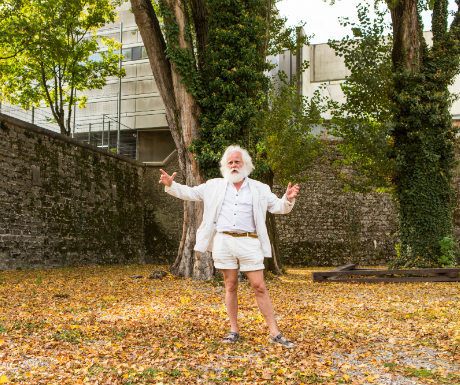 2. Ride a red bubble
This short, but sweet cable car ride was the first of its kind built in 1934. Originally the cars were octagonal in design, with the bubble shape being introduced later on in 1976. As the bubble lifts up into the sky, it hovers over the colourful houses lining the banks of the winding River Isère briefly, before revealing the flattest expanse of city in France, home to just under 160,000 inhabitants. In the distance, misty mountains hug the entire periphery of the city. We float over the rooftops of a derelict university and the Musée Dauphonoise, which is worth a visit on the way down. At the top we are greeted by golden-copper trees now in full autumnal bloom. TIP: Make sure to take the last bubble in the set of four for an unobscured view (or on the way down, the first bubble).
2. Ride a red bubble
This short, but sweet cable car ride was the first of its kind built in 1934. Originally the cars were octagonal in design, with the bubble shape being introduced later on in 1976. As the bubble lifts up into the sky, it hovers over the colourful houses lining the banks of the winding River Isère briefly, before revealing the flattest expanse of city in France, home to just under 160,000 inhabitants. In the distance, misty mountains hug the entire periphery of the city. We float over the rooftops of a derelict university and the Musée Dauphonoise, which is worth a visit on the way down. At the top we are greeted by golden-copper trees now in full autumnal bloom. TIP: Make sure to take the last bubble in the set of four for an unobscured view (or on the way down, the first bubble).
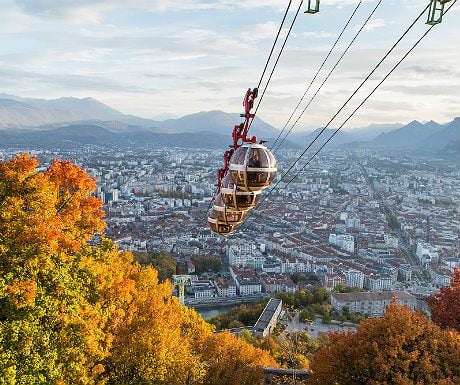 3. Fort de la Bastille
The cable car (or teleferique) lands you right on the walls of this 19th century hill-top fortification. This isn’t just a historical site, it also houses an art exhibition, restaurants, museums, an adventure trail for kids, a zip-line and an array of events throughout the year, which include dancing and music. If you have hiked up, take a coffee and rest at Restaurant le Téléférique while absorbing the incredible panoramic views. It’s a great place to start your trip, as you can get a good idea of the city from this vantage point. Take your time to explore the maze of corridors connected by stone staircases, offering secluded areas for a quiet moment away from the crowds. One steep, narrow staircase leads right down through a dark mountain and out the other side. If you still have energy, just a 30 min easy uphill hike using trail GR9, will take you to the Memorial at Mont Jalla, at an elevation of 643m, the view is even wider but there are a lot less people here. It’s worth staying to watch the city light up as the sun goes down. Every evening, there are hundreds of joggers with headlamps weaving their way up and down the side of the hill. If you choose to walk back down to town, you will be rewarded with a mesmerising light show at the bottom, a projection of moving geometric patterns, like the seed of life, bring the dark stone walls to life. TIP: I recommend bringing a torch, especially if you plan to walk down after sunset as it’s pitch black.
3. Fort de la Bastille
The cable car (or teleferique) lands you right on the walls of this 19th century hill-top fortification. This isn’t just a historical site, it also houses an art exhibition, restaurants, museums, an adventure trail for kids, a zip-line and an array of events throughout the year, which include dancing and music. If you have hiked up, take a coffee and rest at Restaurant le Téléférique while absorbing the incredible panoramic views. It’s a great place to start your trip, as you can get a good idea of the city from this vantage point. Take your time to explore the maze of corridors connected by stone staircases, offering secluded areas for a quiet moment away from the crowds. One steep, narrow staircase leads right down through a dark mountain and out the other side. If you still have energy, just a 30 min easy uphill hike using trail GR9, will take you to the Memorial at Mont Jalla, at an elevation of 643m, the view is even wider but there are a lot less people here. It’s worth staying to watch the city light up as the sun goes down. Every evening, there are hundreds of joggers with headlamps weaving their way up and down the side of the hill. If you choose to walk back down to town, you will be rewarded with a mesmerising light show at the bottom, a projection of moving geometric patterns, like the seed of life, bring the dark stone walls to life. TIP: I recommend bringing a torch, especially if you plan to walk down after sunset as it’s pitch black.
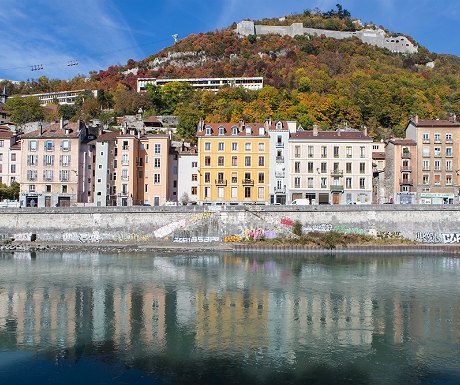 4. Hiking the Col de Vence
There are so many hiking routes it would be impossible to list them all, especially since there are 3 separate mountain ranges to choose from; the Chartreuse, the Vercors and the Belledonne. The Bastille links with the Chartreuse range, so this one is the most accessible from the city centre. Just a 30 minute ride north-west of town, near the Restaurant La Chapelle, a trail leads up through the woods and zig-zags its way under the shade of bronzed trees. Glimpses of the city far below start to appear at each bend in the road. I pass a silver-haired mountain biker who must have been in his 60s. The older generation do like to keep fit here! One hour later, the forest opens up to show hillside caves with iron gates half open, inviting me in to the cool dark interior. Next a steep stone staircase leads up to a windy plateau, where a lone donkey is grazing in the peaceful solitude at an elevation of 1338m . Mont Blanc can be seen in the distance. From here it’s a short walk downhill to Fort du Saint-Eynard, which was built for the protection ofGrenoble in the 1870s, but now houses a museum, restaurant and chapel. The views of the city, again, are magnificent! A small white engine-less glider silently sweeps above my head like a paper plane, I envy the view it must be getting. TIP: For the clearest view, try and hike the day after it has rained, as the rain will clear the thin veil of smog which hangs over the city much of the time.
4. Hiking the Col de Vence
There are so many hiking routes it would be impossible to list them all, especially since there are 3 separate mountain ranges to choose from; the Chartreuse, the Vercors and the Belledonne. The Bastille links with the Chartreuse range, so this one is the most accessible from the city centre. Just a 30 minute ride north-west of town, near the Restaurant La Chapelle, a trail leads up through the woods and zig-zags its way under the shade of bronzed trees. Glimpses of the city far below start to appear at each bend in the road. I pass a silver-haired mountain biker who must have been in his 60s. The older generation do like to keep fit here! One hour later, the forest opens up to show hillside caves with iron gates half open, inviting me in to the cool dark interior. Next a steep stone staircase leads up to a windy plateau, where a lone donkey is grazing in the peaceful solitude at an elevation of 1338m . Mont Blanc can be seen in the distance. From here it’s a short walk downhill to Fort du Saint-Eynard, which was built for the protection ofGrenoble in the 1870s, but now houses a museum, restaurant and chapel. The views of the city, again, are magnificent! A small white engine-less glider silently sweeps above my head like a paper plane, I envy the view it must be getting. TIP: For the clearest view, try and hike the day after it has rained, as the rain will clear the thin veil of smog which hangs over the city much of the time.
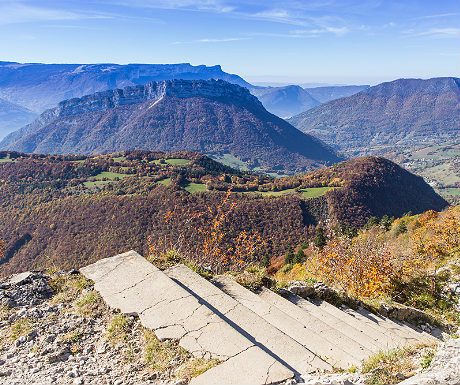 5. Explore the city
The best way to see as much of the city as possible is to hire a bike from the Metrovelo at Grenoble station and get cycling. The city has wide main roads, and smaller pedestrianised streets, making it easy for cyclists, but if you are not a fan of cycling, walking is just as enjoyable. As well as some unusual architecture, such as the Evangelist church pictured below, there’s a fair amount of murals to be found for street-art enthusiasts and gorgeous markets with colourful bouquets of local produce. One of my favourites is the Marche de l’Estacade, which is housed under what looks like a railway. Art nouveau style illustrations of trees and market scenes adorn the columns and facades. For a more centrally located market, try Place aux Herbes on a Sunday.
5. Explore the city
The best way to see as much of the city as possible is to hire a bike from the Metrovelo at Grenoble station and get cycling. The city has wide main roads, and smaller pedestrianised streets, making it easy for cyclists, but if you are not a fan of cycling, walking is just as enjoyable. As well as some unusual architecture, such as the Evangelist church pictured below, there’s a fair amount of murals to be found for street-art enthusiasts and gorgeous markets with colourful bouquets of local produce. One of my favourites is the Marche de l’Estacade, which is housed under what looks like a railway. Art nouveau style illustrations of trees and market scenes adorn the columns and facades. For a more centrally located market, try Place aux Herbes on a Sunday.
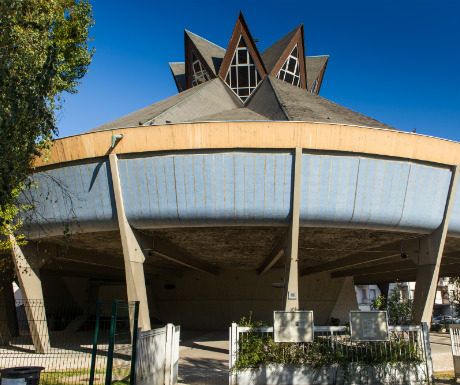 6. Art class at the Musée de Grenoble
The Museum of Grenoble has an inspiring collection of both ancient and contemporary art. As I soak in the colours and shapes, I notice a group of mature students being led by an art teacher. They attempt to sketch a copy of ‘Boxers’, a cubist painting by Vicente Do Rego Monteiro from the 50s, which has soft curved lines and graduated shading. What better place to practice drawing and become part of the artistic process than surrounded by works of art from the great masters! It’s interesting that Grenoblois can even borrow paintings from their local libraries for short periods of time at no cost at all, just like borrowing a book!
6. Art class at the Musée de Grenoble
The Museum of Grenoble has an inspiring collection of both ancient and contemporary art. As I soak in the colours and shapes, I notice a group of mature students being led by an art teacher. They attempt to sketch a copy of ‘Boxers’, a cubist painting by Vicente Do Rego Monteiro from the 50s, which has soft curved lines and graduated shading. What better place to practice drawing and become part of the artistic process than surrounded by works of art from the great masters! It’s interesting that Grenoblois can even borrow paintings from their local libraries for short periods of time at no cost at all, just like borrowing a book!
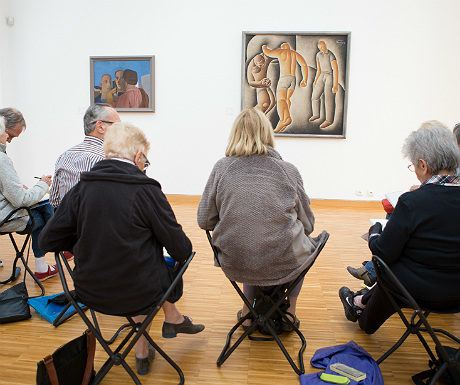 7. La Millesime festival
This locally curated festival is now in its 23rd year and takes place for 2 weeks every October right in the centre of Grenoble. Whether you are an oenophile or a neophyte, you will discover something new every year, with a selection of wines from some 50 producers, as well as foie gras, cheese and meats from select regions. This is all accompanied by live music performances by renowned concert musicians and singers as well as showcasing new talent. The festival really focuses on wine, with tastings, workshops and a large smelling tent with aroma bottles, which give an example of the different notes that can be found within a glass of wine.
7. La Millesime festival
This locally curated festival is now in its 23rd year and takes place for 2 weeks every October right in the centre of Grenoble. Whether you are an oenophile or a neophyte, you will discover something new every year, with a selection of wines from some 50 producers, as well as foie gras, cheese and meats from select regions. This is all accompanied by live music performances by renowned concert musicians and singers as well as showcasing new talent. The festival really focuses on wine, with tastings, workshops and a large smelling tent with aroma bottles, which give an example of the different notes that can be found within a glass of wine.
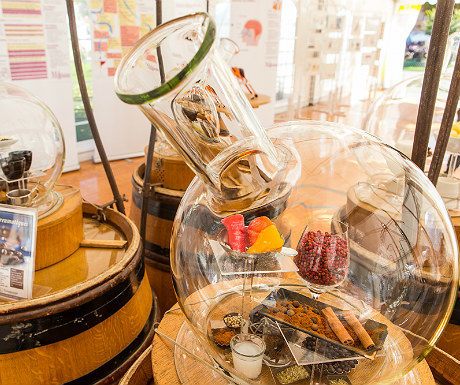 8. Local cuisine
Grenoble is known for traditional dishes such as gratin dauphinois and creme brûlée, but the food in this city is really more varied and exciting. Sitting at the K fee des Jeux, I decide on the ‘Plat du Jour’ which starts with a terrine of herring and raspberry and a walnut salad. Walnuts of exceptional quality are produced in Grenoble, so if you see it on the menu, it’s likely to be a good choice! The second course is a hearty portion of steamy Canard stew, with tender pieces of duck, wild mushrooms and prunes, served with wheatberries. The autumnal theme continued at Le Cotelette restaurant (pictured below) whose rustic brick coves were decorated with dried leaves and wine coloured rugs. Soothing piano music played in the background as I enjoyed a Salmon Tartare and a glass of Chartreuse, which comes in a strong green or sweet yellow version. It’s produced at the local monastery, which sits on the mountain range of the same name, by monks who have taken a vow of silence. The complex flavour comes from a mixture of 130 herbs, flowers and spices which are slowly aged in oak casks. Queen Elizabeth allegedly loves a shot of Chartreuse added to her champagne!
8. Local cuisine
Grenoble is known for traditional dishes such as gratin dauphinois and creme brûlée, but the food in this city is really more varied and exciting. Sitting at the K fee des Jeux, I decide on the ‘Plat du Jour’ which starts with a terrine of herring and raspberry and a walnut salad. Walnuts of exceptional quality are produced in Grenoble, so if you see it on the menu, it’s likely to be a good choice! The second course is a hearty portion of steamy Canard stew, with tender pieces of duck, wild mushrooms and prunes, served with wheatberries. The autumnal theme continued at Le Cotelette restaurant (pictured below) whose rustic brick coves were decorated with dried leaves and wine coloured rugs. Soothing piano music played in the background as I enjoyed a Salmon Tartare and a glass of Chartreuse, which comes in a strong green or sweet yellow version. It’s produced at the local monastery, which sits on the mountain range of the same name, by monks who have taken a vow of silence. The complex flavour comes from a mixture of 130 herbs, flowers and spices which are slowly aged in oak casks. Queen Elizabeth allegedly loves a shot of Chartreuse added to her champagne!
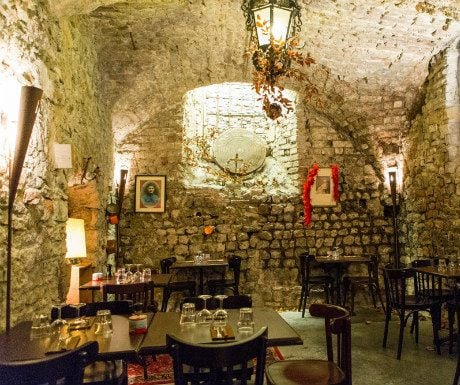 9. Sweet treats
The worst thing about a real French Patisserie, is having to decide which pastry to eat. Time and effort are put into each exquisite hand-made pastry at Paris Delicies. Juicy, shiny fruits sit atop creamy sweet custard on a base of light, fluffy, flaky pastry. For chocolate lovers, look out for Chocolate Walnuts at La Caraque chocolate shop, which make a delicious gift to take away with you.
9. Sweet treats
The worst thing about a real French Patisserie, is having to decide which pastry to eat. Time and effort are put into each exquisite hand-made pastry at Paris Delicies. Juicy, shiny fruits sit atop creamy sweet custard on a base of light, fluffy, flaky pastry. For chocolate lovers, look out for Chocolate Walnuts at La Caraque chocolate shop, which make a delicious gift to take away with you.
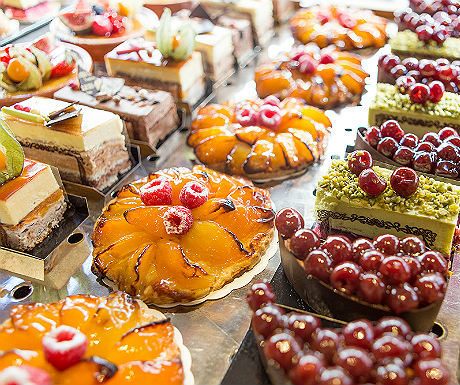
Did you enjoy this article?
Receive similar content direct to your inbox.

